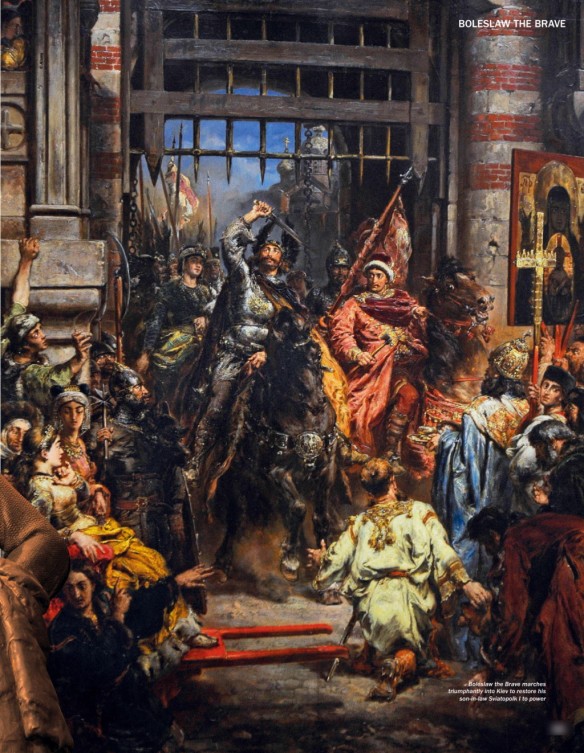
992-1025 Reign of Boleslaw I ‘the Brave’
Boleslaw Chrobry (the Brave), whose brilliant reign started in 992 with a strengthening of Poland’s unity and which had as its main objective the securing of a fully independent and even leading position in East Central Europe.
Boleslaw first hoped to realize his plans in friendly cooperation with the young Emperor Otto III who had a truly universal, supranational conception of the Roman Empire, uniting on equal terms Italy, Gaul, Germany and Sclavinia. In the latter-the Slavic world-the Emperor was prepared to recognize Boleslaw as his vicar (patricius), whose friendly collaboration would promote the missionary activities in which they were both deeply interested. Their common friend, Adalbert, the former Bishop of Prague, having been killed in 997 on a mission in Prussia, was soon afterwards canonized by Pope Sylvester II. At Easter of the year 1000, Otto III made a pilgrimage to Poland’s capital, Gniezno, where Boleslaw had buried the redeemed body of the martyr. At a solemn convention attended by a papal legate, Poland received a fully independent ecclesiastical organization with an archbishop in Gniezno and new bishops in Cracow, Wroclaw (Breslau in Silesia), and Kolobrzeg (Kolberg in Pomerania).
The political decisions of the congress of Gniezno made Boleslaw -like his father a former tributarius of the Empire-a real dominus, that is, an independent ruler to whom most probably the royal dignity was promised. Some obscure intrigues at the Roman curia delayed the planned coronation, however, and in 1002 the death of Otto III altogether changed the situation. Fully aware of the danger of German imperialism which reappeared under the new emperor, Henry II, the Polish duke decided to oppose his policy by uniting all Western Slavs in some kind of federation under Poland’s leadership.
That project included two different problems. Boleslaw wanted first of all to save from German domination and to include in his realm as much as possible of the Slavic territory between Germany and Poland. Therefore in 1002 he occupied Lusatia and Misnia (Meissen), where a residuum of the Slavic population was to survive until our day. Even more important was the idea of replacing German influence in Bohemia by Polish authority.
Interfering with internal rivalries among the members of the Premyslid dynasty, in the following year Boleslaw entered Prague and the creation of a common Polish-Czech state seemed nearer than in any later period of history.
But Henry II reacted by declaring a war which, twice interrupted by truces, lasted sixteen years. The final peace was concluded in 1018 in Budziszyn (Bautzen), the capital of Lusatia, which definitely remained under Boleslaw’s full sovereignty. He did not, however, succeed in gaining any other Slavic lands between the Oder and Elbe rivers, where the strongest tribe, the Lutitians, even cooperated with the German invaders, thus preparing their final doom. There was also a German party in Bohemia which the Poles had to evacuate in 1004. Boleslaw kept only Moravia, so that the state of the Premyslids was temporarily divided between the Empire and Poland.
In 1013, in the midst of the German war, Poland was for the first time threatened by a joint action of her western and eastern neighbors, the Emperor having resumed earlier German relations with the Kievan State. That was probably one of the reasons why Boleslaw, immediately after the Treaty of Budziszyn, decided to interfere with the internal struggle among the sons of Vladimir of Kiev, supporting the one who had married his daughter. When he occupied Kiev in that same year of 1018 and there established the rule of his son-in-law, Sviatopolk, it seemed that even the Eastern Slavs would be included in Boleslaw’s federal system. The message which he sent from Kiev to both emperors, Henry II of Germany and Basil II of Byzantium, was a clear expression of his aim to keep the whole of East Central Europe free from any imperial authority.
Boleslaw’s influence reached as far as the Lithuanian border, where another missionary whom he supported, his German admirer St. Bruno, was killed in 1009, and also into Hungary, although it is doubtful whether he ever united any Slovak territories with Poland. His coronation as first King of Poland which with papal approval took place shortly before his death in 1025, finally confirmed Poland’s position as an independent member of the European community.
The royal tradition of Boleslaw Chrobry remained alive throughout the whole course of Polish history, although already under his son and successor, Mieszko II (1025-1034), crowned immediately after his father’s death, Poland lost her leading position and entered a serious internal crisis that opened the door to German intervention. Lost were also the first king’s territorial acquisitions, Lusatia and Moravia, the former coming definitely under German control and the latter returning to Bohemia. In spite of a fierce but unorganized resistance, the Slavic tribes west of Poland were absorbed by the Empire, which also continued to include the state of the Premyslids.